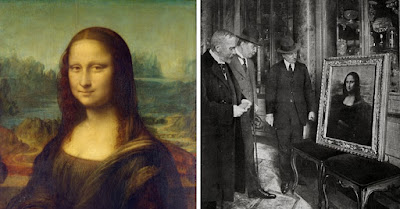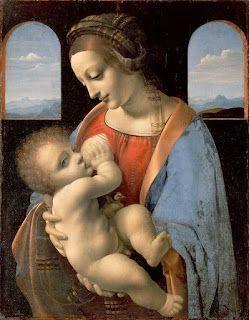The Italian Renaissance(ruh-nei-sawns)
In painting,
this unique approach was characterized by spiritual iconography, flat
compositions, unrealistic color palettes, and ethereal, other worldly figures.
In the 1300s, however, Italian artists based in Florence abandoned this
distinctive aesthetic and adopted a more humanist approach to art. It would be known as the Italian Renaissance.

Renaissance Art

The halfhearted or even ambiguous nature of this smile makes
the iconic painting all the more enigmatic, prompting viewers to try to
understand both the mood of its muse and the intention of its artist..
What
are the “perfect” proportions?
- four fingers equal one palm
- four palms equal one foot
- six palms make one cubit
- four cubits equal a man’s height
- four cubits equal one pace
- 24 palms equal one man
The
Italian Renaissance occurred between the 14th and 17 centuries in Italy.
Derived from the word Rinascimento, or “rebirth,” the
Renaissance is generally seen as an enlightened age of art.
During the Dark Ages (approximately
500-1000 AD), Italian art was predominantly rooted in religion.
Italian Renaissance regarded as a golden age of art, music, and literature, the period has
inspired creatives for centuries, with iconic works by master artists like
Leonardo da Vinci and Michelangelo.
Leonardo da Vinci possessed a rare kind of cross-disciplinary genius. He was a painter, engineer, architect, sculptor, scientist,inventor and futurist .
The Mona Lisa is an oil painting by Italian artist Leonardo da Vinci. The piece features a portrait of a seated woman set against an imaginary landscape.
The Mona Lisa painted from 1503, when he started it, to his deathbed in 1519.
Leonardo spent many pages in his notebook dissecting the human face to figure out every muscle and nerve that touched the lips. He was trying to get every aspect exactly right in layer after layer. If you look directly at the Mona Lisa smile, the corners of the lips turn downward slightly, but shadows and light make it seem like it’s turning upwards. As you move your eyes across her face the smile flickers on and off.
“Mona Lisa” is the culmination conclusion/finale) because the emotions that she’s expressing, just like her
smile, are a bit elusive (subtle). Every time you look at her it seems slightly
different. Unlike other portraits of the time, this is not just a flat,
surface(superficial) depiction. It tries to depict the inner emotions.
The
figure sits with her arms folded as she gazes at the viewer and appears to
softly smile—an aesthetic attribute that has proven particularly eye-catching
over centuries.
This figure of a woman, dressed in the Florentine fashion of her day and seated in a visionary, mountainous landscape, is a remarkable instance of Leonardo's sfumato technique of soft, heavily shaded modeling. The Mona Lisa's enigmatic expression, which seems both alluring and aloof, has given the portrait universal fame.
The portrait shows the subject sitting upright and sideways in a chair, with her face and chest turned slightly towards the viewer: a posture derived from the 'pyramid' image used to depict a sitting Madonna. Her left arm sits comfortably on the armrest of the chair and is clasped by the hand of her right arm which crosses her front. The slightly protective position of her arms, as well as the armrest, creates a sense of distance between sitter and spectator.
The background landscape behind the sitter was created using aerial perspective, with its smoky blues and no clearly defined vanishing point. It gives the composition significant depth, although its details reveal a clear imbalance between the (higher) rocky horizon to the right, compared to the (lower) flatlands stretching away on the left. This imbalance adds to the slightly surreal atmosphere of the picture.
The way Leonardo painted this portrait deviated from the traditional way women were painted like this in Italy. Mona Lisa looks directly out at us, the viewers, which was something unconventional for a woman in a portrait to do at this time. She also appears rather content and assured in her demeanor, which reflected more the expectations of the aristocracy among men rather than among women. Further, until this point in time, portraits of both men and women were typically cut off in the middle of torso and hands were raised so that we the head and face and shoulders occupies more of the panel upon which the paint was applied. Here, however, the portrait shows not only the woman’s head and upper torso, but much of her body down to just below her waist. We see all of her arms, which are not raised up but resting comfortably on the armrests of her chair.
The Duke of Milan asked him to
paint it on the wall of a dining hall of a monastery. Leonardo doesn’t just
capture a moment. He makes “The Last Supper” a dramatic narrative. As you walk
in the door, you see Christ’s hand then, going up the arm, you stare at his
face. He’s saying, “One of you shall betray me.” As your eyes move across the
picture, you see that sound almost rippling outward as each of the groups of
apostles reacts. Those nearest to him are already saying, “Is it me, Lord?” The
ones further away have just started to hear it. As the drama ripples from the
center to the edges, it seems to bounce back, as Christ reaches for the bread
and wine, the beginning of what will be the institution of the Eucharist.
He liked to think of himself as
an engineer and architect, which he also did with great passion. But his first
job was as a theatrical producer.
From that he learned how to do
tricks with perspective because the stage in a theatre recedes faster and looks
deeper than it is. Even a table onstage would be tilted slightly so you can see
it, which is also what we see in “The Last Supper.” Likewise, on the stage, the
theatrical gestures of the characters would be exaggerated, which is what you
also see in “The Last Supper.”
Vitruvian From
how the Vitruvian Man revolutionized
the anatomical understanding of human proportions to Leonardo’s fascination
with the brain to what his flying machine sketches taught the designers and
engineers of the then-future presents a remarkable reminder of the
cross-disciplinary curiosity and rigorous dedication that fueled one of
humanity’s most prolific, profound and masterful creators.
Intended to
explore the idea of proportion, the piece is part work of art and part
mathematical diagram, conveying the Old Master‘s belief that “everything connects
to everything else.”
The Vitruvian Man is based on De Architectura, a building guide written
by Roman architect and engineer Vitruvius between 30
and 15 BC. While it is focused on architecture, the treatise also explores the
human body—namely, the geometry of “perfect” proportions—which appealed to
Leonardo’s interest in anatomy and inspired his drawing.
Leonardo da Vinci, who is
interested in everything that could possibly be known about the universe,
including how we fit into it. That made him a joyous character to write about.
In his notebooks, we see such
questions as, describe the tongue of the woodpecker. Why do people yawn? Why is
the sky blue? He is passionately curious about everyday phenomenon that most of
us qu
it questioning once we get out of our wonder years and become a bit jaded.
 Being curious about everything and
curious just for curiosity’s sake, not simply because it’s useful, is the
defining trait of Leonardo. It’s how he pushed himself and taught himself to be
a genius. We’ll never emulate Einstein’s mathematical ability. But we can all
try to learn from, and copy, Leonardo’s curiosity.
Being curious about everything and
curious just for curiosity’s sake, not simply because it’s useful, is the
defining trait of Leonardo. It’s how he pushed himself and taught himself to be
a genius. We’ll never emulate Einstein’s mathematical ability. But we can all
try to learn from, and copy, Leonardo’s curiosity.
In
the first, Leonardo notes that, according to Vitruvius, these are the
measurements of the ideal body:
Additionally,
the first set of notes also specifies: “If you open your legs so much as to
decrease your height 1/14 and spread and raise your arms till your middle
fingers touch the level of the top of your head you must know that the
center of the outspread limbs will be in the navel and the space between
the legs will be an equilateral triangle. The length of a man’s outspread
arms is equal to his height.”






















Interesting blog, it reminds me of Leonardo da Vinci saying: "Details make perfection, and perfection is not a detail. For instance, experience shows us that the air must have darkness beyond it and yet it appears blue."
ReplyDeleteI tried to write a blog about him, hope you also like it: https://stenote.blogspot.com/2018/03/an-interview-with-leonardo.html